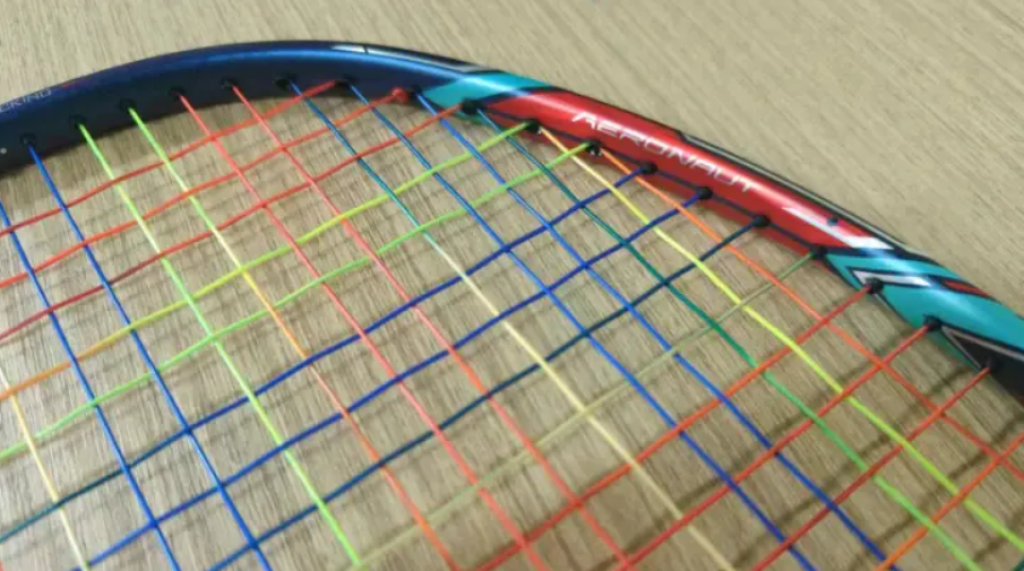As a Mid-Generation Li-Ning Flagship
This racket not only stands out in the AERONAUT 9000 series for its impressive offensive capabilities but has also accompanied Zheng Siwei in his relentless journey of success. Based on its popularity and reputation, it aligns well with my initial understanding of it.
Despite its widespread use and stable price, which has never plummeted, I hesitated to try it out for a long time. Sometimes, when I see fellow players using it, I feel too shy to ask to borrow such an expensive racket. I’m grateful to a friend for sharing their equipment.

Specifications: 3UG6, with towel grip removed, total weight in use is 93.86g, balance point 310mm, shaft length 210mm, medium stiffness, box-shaped frame, 72-hole stringing, 9-3 point grooves, 32 lbs string tension, strung with 26-28 lbs BS720.
The visual design of the racket is quite impactful. The color choices—deep blue, bright blue, and scarlet—have a distinctly Chinese style, reminiscent of the glaze on ancient artifacts carefully restored by archaeologists, making it highly recognizable. Some players mentioned that this design is reminiscent of the AT900T from the green factory but with a brighter tone, which I admit is beyond my knowledge. However, due to this distinctiveness, the racket has become a prime target for counterfeiters.

Although I knew this was a 3U racket with a bias toward offensive play, my initial impression didn’t overwhelm me. No doubt, it has slightly higher swing weight compared to the AERONAUT 9000, but overall, it still falls into the category of balanced rackets. If its current weight distribution were reduced to a 4U specification, it wouldn’t feel much different from the Zhan Ji 6000 I previously tested in terms of an empty racket experience.
The shaft isn’t overly stiff, comparable in quality to its siblings. When handling incoming shots, the ability to borrow force is clear, and it’s easy to drive and feel the shaft’s flex in the AERONAUT 9000C. The feedback from hitting the shuttle isn’t much different from the AERONAUT 9000; in fact, it’s quite user-friendly, with a slightly sweet spot, making it easy to get used to. The box-shaped frame also provides good torsional resistance, performing well in directional control, allowing for precise placement in the small back corners of the court.

People often say that the AERONAUT technology enhances swing speed. Since Fat Tiger has already done a control variable experiment, I won’t delve into whether the AERONAUT frame or a box frame with the same projected area is better. At least in doubles, on a day when I was in good form, the racket allowed for fast-paced exchanges. Although the increased swing weight reduces agility, the longer grip effectively prevents the generation of large moments of force.
However, the feel of the racket face isn’t typical or aggressive. Unlike the trendy “hit and go” feel, the AERONAUT 9000C has a noticeably more pronounced hold on the shuttle. But this isn’t an excuse, as Zheng Siwei has transitioned from the AERONAUT 9000C to the Duora 10 LT and now the Arcsaber 11 Pro. It’s also said that he prefers the BG65 string, indicating that racket face characteristics are more about personal preference than specific scenarios.

In the attack department, which is its proudest aspect, the AERONAUT 9000C gave me a rather “average” experience. The racket imparts energy to the shuttle through both gravity and elasticity, with a nearly equal balance. As one of Li-Ning’s best shafts at the time, its performance is still solid today but slightly behind current standards. I’m not sure if it was intentional, but within the 9-series, the Windstorm’s ferocity is indeed more apparent than the AERONAUT’s, giving more confidence in shots.

That said, the downward pressure feel of the AERONAUT 9000C is slightly higher than that of the AERONAUT 9000. When exerting full power for heavy smashes, the shaft’s flex is less pronounced than the AERONAUT 9000, with a more resistant feel, allowing you to sense the whip-like motion at the end of the swing, especially in the racket head. Using stiffer strings might maximize the power output. It’s not difficult to execute smashes, and both downward pressure and power reach a certain level, making it sufficiently aggressive. However, to deliver a truly threatening shot, the player needs to rely on their own skill and maintain a continuous flow.

Even though it bears the C suffix, I haven’t seen any fellow players around me instantly unlock their heavy smash or continuous downward pressure capabilities after switching to the AERONAUT 9000C. The retail version of the AERONAUT 9000C is still fundamentally a relatively balanced racket with some offensive specialties. After using several other AERONAUT rackets, I don’t find the AERONAUT 9000C to have any outstanding qualities. Moreover, its series-specific hold on the shuttle gives me more confidence in net play, rear-court slices, and slides, leading to a slightly better impression in controlling tempo changes on the court.
Based on this understanding, after using all four AERONAUT 9000 siblings, I might still find myself missing the days spent with the AERONAUT 9000 the most.

Leave a Reply